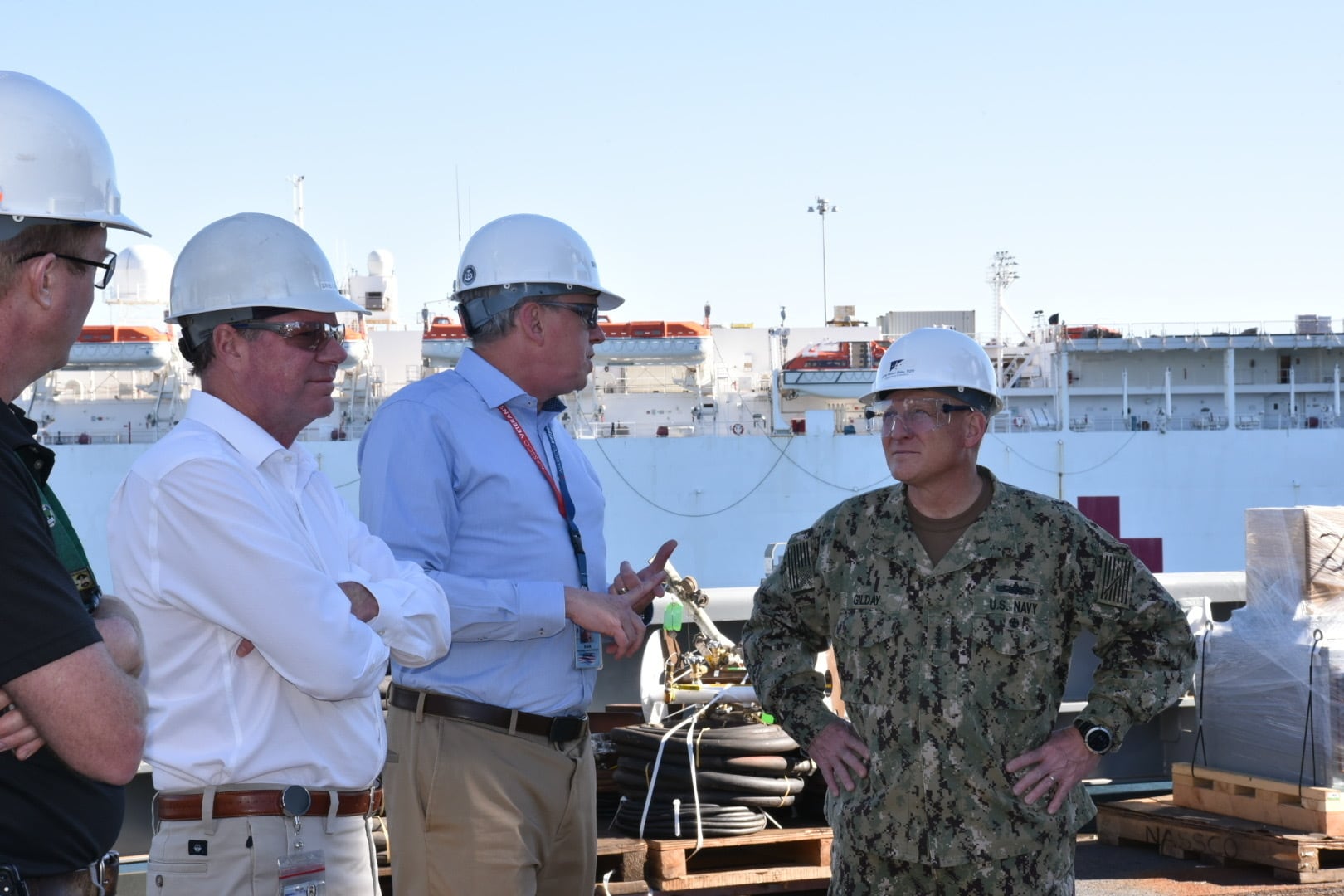NORFOLK, Va. — The U.S. Navy’s cruiser modernization program has been disorganized in its planning and troubled in its execution, service leaders have told Defense News. But it’s a silver lining for those working on destroyers, as they’re able to learn from mistakes in the cruiser effort and avoid repeating them.
The Navy’s massive upgrade project involved cruisers receiving improved combat systems, sensors and computers, as well as fixes to their aging hulls and mechanical and electrical systems. Now, as the service launches a destroyer modernization plan — much smaller in scope, but susceptible to similar challenges — those in the cruiser community are looking to help.
Seven cruisers were put into a particular variation of the modernization program as part of plans to extend the life of the Ticonderoga-class guided-missile cruisers: They’d undergo an initial maintenance availability to modernize areas like the galley; go into a reduced operating status with a skeleton crew of about 35 sailors watching over the ship pierside for several years; go into a one-year availability to prepare for dry docking; and then conduct an “extended dry-docking selected restricted availability” where the bulk of the work would be done.
The first cruiser, Gettysburg, is nearing the end of that process and will go to sea this year, after its 2014 entrance into the service life-extension effort.
At the same time, the destroyer Pinckney is at the General Dynamics NASSCO shipyard in San Diego, California, for the “crawl phase” of the DDG Mod 2.0 program. While there, the ship will receive the Surface Electronic Warfare Improvement Program (SEWIP) Block 3, go on deployment, and then return to receive the SPY-6(V)4 air and missile defense radar.
The DDG Mod 2.0 program will eventually conduct the SEWIP and SPY-6 upgrades at the same time in a longer availability. For now, Pinckney and a few other vessels will undergo this “smart start” process so the Navy can begin learning lessons on SEWIP installation, even as SPY-6 lessons are learned separately though integration work at land-based engineering sites and aboard the first Flight III destroyers being built with a variant of the SPY-6, Capt. Matthew Tardy, the surface ship modernization program manager at Naval Sea Systems Command, said in January at the Surface Navy Association conference.

Though the two modernization efforts differ in scope and duration, Commander of Naval Surface Forces Vice Adm. Roy Kitchener, told reporters in January that the Navy must ensure proper planning and oversight to avoid the delays that plagued the cruiser program.
“That’s a very complex availability, a lot of work when you’re taking SPY-6 and then integrating it with SEWIP and integrating it with another combat system. There’s a lot of work there, and I think we need to make sure we have that right, we have the proper oversight,” he said. “They’re lengthy, they’re challenging. We need to make sure that we get them done quickly and efficiently because it’s a great capability that we need to get out … to the force.”
The problem with cruiser modernizations
Chief of Naval Operations Adm. Michael Gilday recently visited the cruiser Gettysburg — the first cruiser that will come out of this program, and a ship where he served as executive officer earlier in his career. Defense News joined the CNO during the Feb. 4 tour.
“We’re in year three of a one-year avail[ability]. We were expecting to be complete almost two years ago,” Gettysburg’s commanding officer, Capt. Megan Thomas, told Gilday during the visit.
The cruiser receiving significant updates to its combat and computer systems, including upgrading to the Baseline 9 version of the Aegis Combat System, receiving the Consolidated Afloat Networks and Enterprise Services system, modernizing to the newest configurations of the AN/SLQ-32C(V)6 and the AN/SQQ-89(V)15, undergoing Cooperative Engagement Capability upgrades, and more. These processes, however, involve a lot of challenging cable work.
On the hull, mechanical and electrical — or HM&E — side of things, the 30-year-old cruiser received upgrades throughout the nearly eight-year modernization program. Some systems were fixed early on but sat unused while the ship was in reduced operating status for years, so getting them up and running is proving a challenge, Thomas said.
“Ventilation is probably our most troubled system right now,” she noted.
Few other ships in the fleet use the same outdated ventilation system, she explained, so the maintenance team had to fix components, such as motors, that might otherwise have been replaced if spare parts were available.
“A lot of the electrical connections associated with the motor controllers have degraded over time. And of course we had a large amount of contractors on and off this ship that are doing a lot of other cabling work,” which has caused damage to some of the ventilation system, she told Gilday.
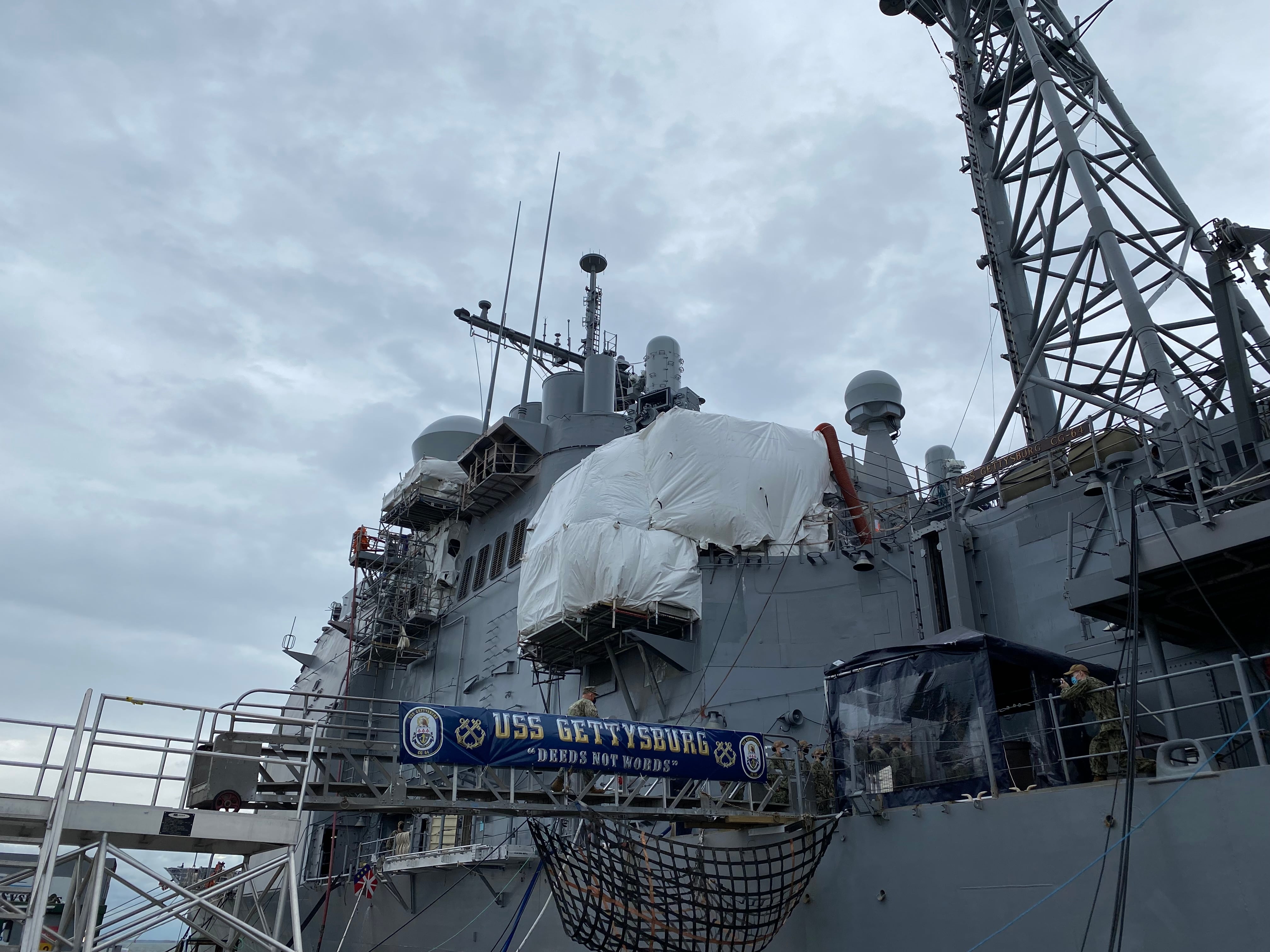
She noted that Gettysburg hasn’t experience tank issues, but its fuel tanks haven’t been refueled yet. Tanks have been an ongoing headache for the cruiser fleet; Vella Gulf was sidelined as it tried to deploy in March 2021 because of fuel tank cracks, and Lake Champlain required repeated maintenance during its deployment to the Indo-Pacific region in 2017.
Thomas said Gettysburg will fuel up to about 60% to ensure no cracks in the fuel tank emerge; then 80% for additional leakage testing; and then fully refuel at sea while still testing for cracks and corrosion along the way.
The ship is to go to sea for HM&E trials in June, and it will soon kick off a lengthy 30-week process of combat system testing.
“We’ve been really trying to just claw our way back to get to milestones and really build some momentum,” Thomas told Gilday, noting that delays have harmed crew morale.
Gilday said Gettysburg’s experience confirmed what he was previously told about the cruiser program’s troubled life-extension efforts.
“We’re trying to drive down maintenance delay days,” Gilday said during the meeting. “In 2019, we had about 7,700, and right now for ‘22 we’re looking at about 2,200. Of those 2,200, 1,200 belong to four cruisers and an [amphibious dock landing ship].
Gilday also cited the significant cost of keeping old cruisers ready for missions: more than $80 million in unplanned maintenance costs in FY22 as well as a strain on the limited ship repair workforce. For those reasons, he reaffirmed his desire to retire some of the cruisers earlier than planned — “not Gettysburg, but other hulls,” he told Thomas — despite congressional opposition throughout the last decade.
Silver lining
Though there’s little for the Gettysburg crew to do now other than try to stay on schedule, Thomas has identified lessons learned that can be applied to other cruiser and destroyer modernization programs.
A key issue for Gettysburg was planning. Thomas said the original work plan called for concurrent activity by BAE Systems and multiple subcontractors in various spaces on the ship, but that work was poorly deconflicted.
“There needs to be a lot more planning in advance of the execution of an avail[ability] that’s going to be of this size, because as the contractors, subcontractors and [alteration installation teams] are all clamoring to get into the same space, we have definitely learned some lessons about sequencing of work,” she told Gilday.
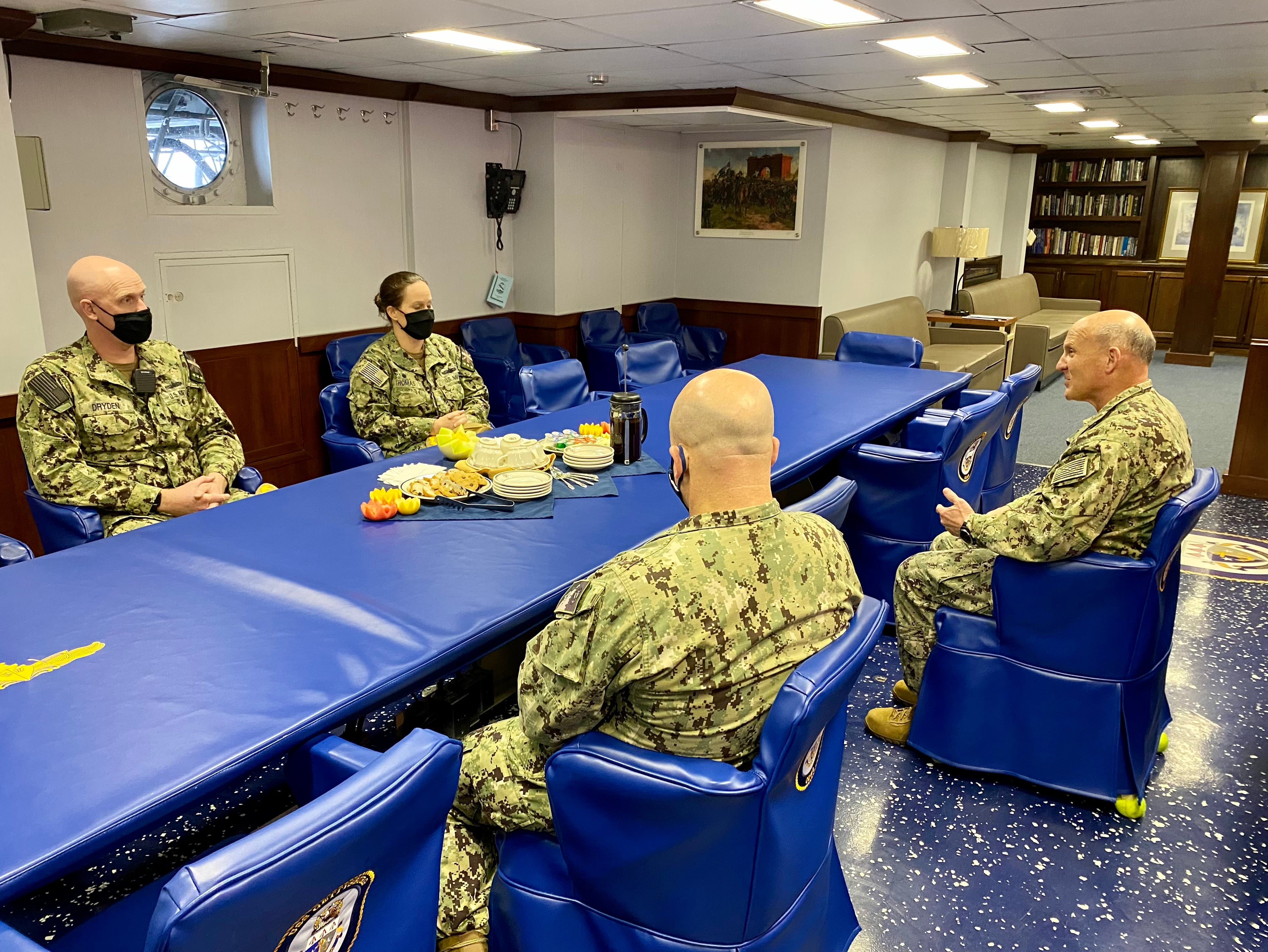
Thomas told Defense News in an interview aboard the ship that miles of new cables were installed, but some of it got pulled loose as other work took place after installation.
“In one of our spaces, computer central, the ordering, the sequence of the work that I referenced, was problematic in that they put in the new cabinets and then they came in and did all the cabling, which runs in the false deck underneath it,” she said. “Sitting in the seats that we are now, it’s kind of like: How did we not see that? But it’s different companies doing these items, and so it really takes a full collaborative effort to make sure that those communications — whether it’s restoration meetings, or it’s daily production meetings — that everybody is sharing the information that they need to hear so that we’re not having to duplicate effort.”
Her crew also learned lessons about proper crewing during a major maintenance availability. Because the cruiser modernization program lasts so long, none of the sailors assigned to the ship before going into the Service Life Extension Program, or SLEP, are still around during the critical dry docking period and the effort to bring the ship back to life. This can be challenging, Thomas said, and she encouraged other cruiser captains to bring in expertise or send sailors to gain expertise on other ships to ultimately help with the most critical and complex parts of the SLEP.
“I have one sailor who was assigned to USS Gettysburg before it went into SLEP, and now he came back as a first class [petty officer] and now he’s a chief — so great to kind of have that continuity, but 1 out of 338 does not a crew make,” she explained.
Thomas has also developed a color-coded watch bill that identifies which crew members are qualified for which watch stations as well as who has previous cruiser experience. This helped her perform targeted cross-decking with other East Coast cruisers to get her watch team at-sea experience in addition to their classroom and pierside training.
Thomas praised Naval Sea Systems Command for providing technical expertise, and she recommended other ship captains coming out of lengthy modernization periods lean on the organization’s resources for help — especially because so few sailors, relatively speaking, have experience on cruisers.
“NAVSEA has worked to give us a number of people, senior enlisted folks, to be able to help understand, troubleshoot and correct material issues. That’s great for us — especially our apprentice-level and even some of our journeymen-level individuals who don’t know necessarily what right looks like. So they need that senior leadership walking alongside them to help them understand that condition,” she said.
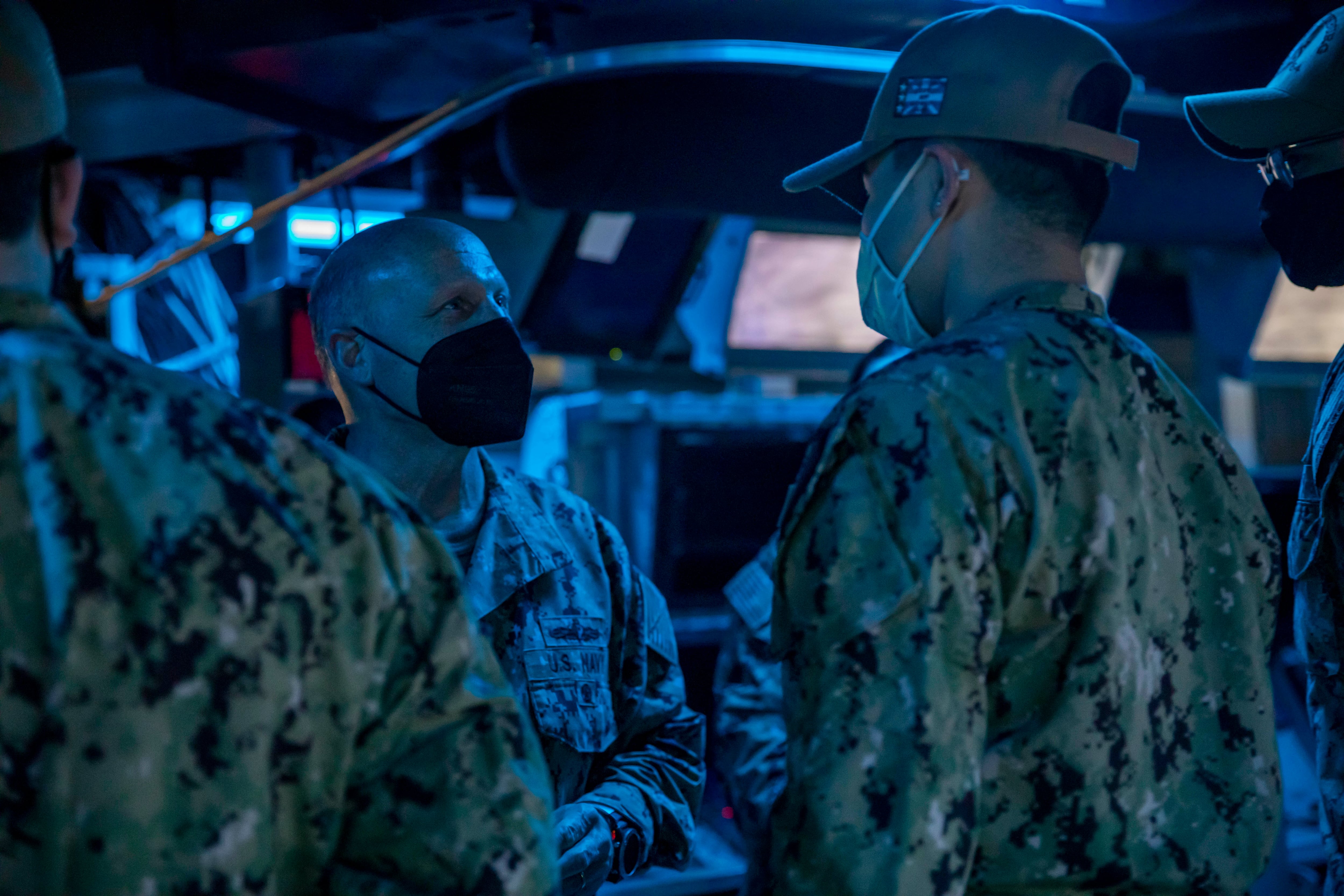
She also recommended cruiser captains pay close attention to crew morale while contractors work on their ships. “Sailors join the Navy to get underway and see the world. And as we have gone through this availability, the number of times the goal posts have shifted has been very frustrating for them. So that’s why we have kind of worked in closer-in goals, so that they’re more achievable goals.”
Thomas and the crew have tried to celebrate each point of progress this year. Upon their arrival in Naval Station Norfolk from the BAE Systems shipyard, the NAVSEA fleet integration team welcomed the ship on the pier with “Welcome Back, Gettysburg” signs, she said, and “they stopped wearing hard hats for the first time.”
“So that was one of the first questions I was asked is: ‘Captain, do we need to wear hard hats when we go to Naval Station Norfolk?’ So I mean, that was a huge morale booster,” she added. “There’s an end in sight.”
Doing it different for destroyers
Looking to the destroyer modernization program, Thomas said the Navy is avoiding the biggest mistake: putting HM&E systems down for so long and then trying to restart them again.
She also hopes the DDG effort will focus on sequencing of the work, especially with the longer availabilities involving the SPY-6 and SEWIP installations on top of HM&E work; and she hopes technical experts will be kept on site as crews become familiar with their new gear and begin taking ownership of it.
Tardy — the surface ship modernization program manager at NAVSEA — said he doesn’t want to draw too close a comparison between the cruiser modernization effort and the upcoming DDG Mod 2.0 program. Many of the cruiser challenges stem from the ship’s long-term reduced operating status, which isn’t part of the plan for destroyers.
But Tardy did say the Navy learned much about getting systems up and running after a long maintenance period. The crawl-walk-run approach to DDG Mod 2.0 lowers the risk.
“We’re very conscious of making sure that those availabilities are executed and done correctly,” he said, with everything being done with an eye toward buying down integration risk early in the process.
Pinckney and a couple other destroyers will get the SEWIP installation only in their first availability, allowing shipyards like NASSCO to learn best practices for installation and integration.
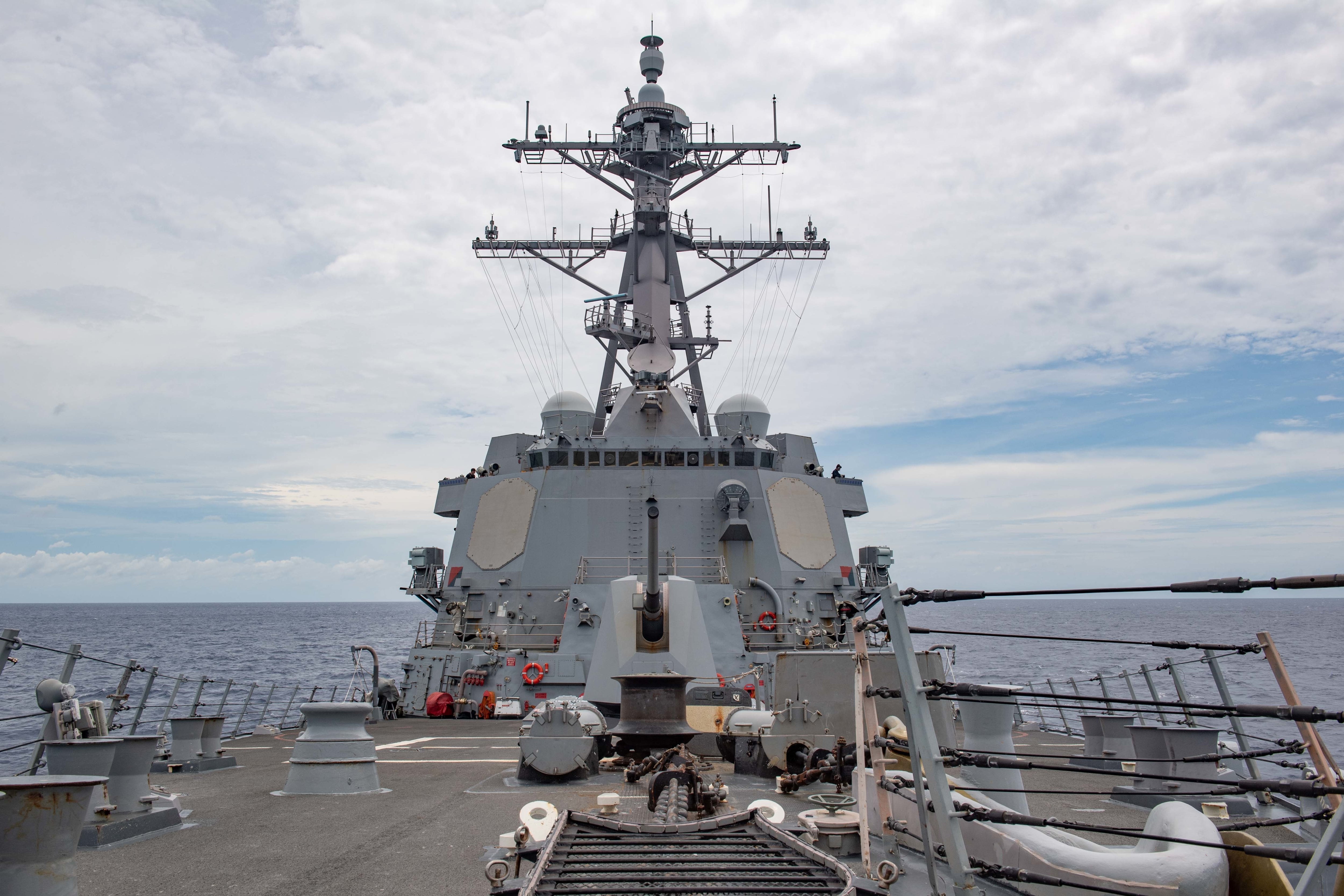
Simultaneously, crews elsewhere are learning about SPY-6 installation and integration. The first radar has been installed on the Jack Lucas, the first Flight III destroyer being built at Ingalls Shipbuilding in Mississippi.
Between lessons being learned at Ingalls and fellow destroyer-builder Bath Iron Works in Maine, and at land-based test sites such as Lockheed Martin’s Moorestown, New Jersey-based Aegis Combat System test site, the Navy will have a good sense of how best to integrate the radar onto the destroyers.
“The real key, I think, is to make sure we involve all our stakeholders — so industry partners, our new construction counterparts, [Naval Sea Systems Command] and the [program executive offices] — so that we take the lessons that we’re learning on the SPY-6 that’s being installed there so we can apply over to the in-service side when we backfit,” Tardy said.
Dave Baker, NASSCO’s vice president for repair, told Defense News in a Feb. 15 visit to the San Diego yard that Pinckney’s availability — which includes the normal scope of a dry docking availability, plus the SEWIP installation — allows the company to focus on significant structural work associated with SEWIP installation without worrying about the SPY-6 radar just yet.
Older versions of the AN/SLQ-32 electronic warfare system were affixed to the destroyer below the bridge wing, above a platform for sailors to access and maintain the system. That entire area will now be enclosed in what Baker called “bug eyes” on either side of the ship. Those steel structures are complex and have to maintain just the right angles and flat surfaces for the system’s arrays.
Baker said NASSCO spent a lot of time understanding how to build, lift and install the steel pieces and then integrate the SEWIP system, but he acknowledged lessons learned would have to be captured and rolled into clean-sheet designs to inform future SEWIP installations as part of DDG Mod 2.0.
Pinckney’s availability began in October and is on track to end a few months early, around May 2023, at which point the Navy can combine lessons learned on SEWIP installation from NASSCO with those for SPY-6 installation in order to craft a plan for the longer modernization periods.
Megan Eckstein is the naval warfare reporter at Defense News. She has covered military news since 2009, with a focus on U.S. Navy and Marine Corps operations, acquisition programs and budgets. She has reported from four geographic fleets and is happiest when she’s filing stories from a ship. Megan is a University of Maryland alumna.
